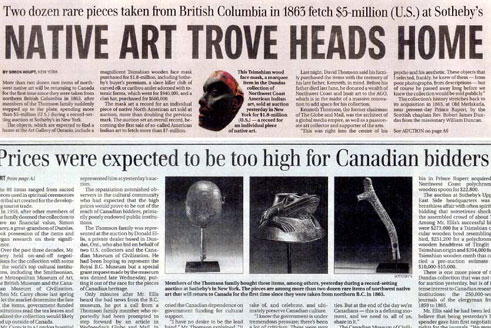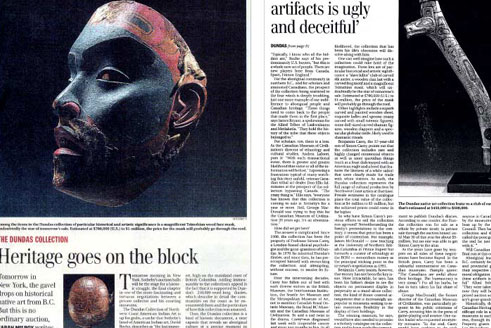
Thomson Family Ensures Return of Dundas Collection
The Globe and Mail announces that private donors enabled the return of several highly important works from the Dundas Collection of Northwest Coast First Nations art to Canada
ca. 1750
elk antler
width: 18 ½"
Inventory # N2978-6
Sold
acquired by the Thomson Collection now at the Art Gallery of Ontario
acquired by the Scottish Reverend Robert J. Dundas from Anglican lay minister William Duncan in 1863 at the village of Metlakatla, British Columbia
by descent in the family
Simon Carey, London, United Kingdom
Sotheby’s New York, Oct 5, 2006, lot 35
Donald Ellis Gallery, Dundas, ON
Thomson Collection, Toronto, ON
Art Gallery of Ontario, Toronto, ON
Donald Ellis, ed., Tsimshian Treasures: The Remarkable Journey of the Dundas Collection, Vancouver: Douglas & McIntyre, 2007, pgs. 80-81
Ted J. Brasser, Native American Clothing: An Illustrated History, Toronto: Firefly Books, 2009, pg. 285
The present antler club was acquired by the Scottish Reverend Robert J. Dundas from the English lay missionary William Duncan on a trip to Canada in 1863. In 1862, Duncan had established a model Church of England mission at Old Metlakatla, an abandoned settlement near Prince Rupert, B.C. Dundas acquired almost 80 objects from Duncan, including crest helmets, rattles and antler clubs which remained in the Dundas family for several generations.
The old, archaic style of two-dimensional design that envelops this remarkable and elegantly fearsome weapon, along with the golden tone of its surface patina, is the best indication that this is one of the oldest artifacts in the Dundas Collection. Northwest Coast formline design tradition began with a core group of basic principles and conventions that steadily expanded over time, generation by generation. The art style grew by incorporating new ideas and innovations that individual artists contributed along the way. Each new innovation picked up and retained by successive practitioners became a part of the evolving tradition. By the time of Rev. Dundas’ visit to Metlakatla in 1863, Tsimshian artists that worked in the formline style had already developed an extraordinary new design manifestation. The circa 1750 time period attributed to this club may, in fact, be somewhat conservative. The appearance of the club has more in common with formline art of 500 to 1000 years before 1750 than with formline are from 100 years after 1750. This club and other examples indicate that 19th-century Tsimshian formline art developed through an earlier period of what we now look back on as the archaic style of Northwest Coast design.
The imagery of this club are as interesting and as beautifully executed relief carving and sculptural that define its parts. The protruding animal head, carved from the stub of an antler tine, appears to represent a wolf, based on its length and proportions. The humanoid head above it at the top of the club may represent the progenitor of the clan, the first owner of the wolf crest. The shoulders and forelegs of the wolf are tucked below and behind the head, with its forepaws reaching forward and turning down near the center line of the club.
Below the wolf’s forefeet, another creature image is composed using only a few simple design movements. It has a fairly long, powerful head and neck, with sharp, triangular teeth clearly depicted. A movement composed of three U-shapes flows downward from the back of the head, and another design movement reaches forward from the grip area of the club handle toward the back corner of the lower jaw. This set of formlines suggests ahind flipper of the kind that is seen in sea lion designs. If this figure is indeed a sea lion, then the design composed here represents the head, pectoral flippers, and tail flippers of this powerful sea mammal.
Objects like this are impressive on many levels – as a fearsome weapon wielded by a trained warrior, as a visual display of clan history and mythology, as a beautifully adapted natural material and as a grand piece of utilitarian sculpture darkened and polished by generations of handling and use.

The Globe and Mail announces that private donors enabled the return of several highly important works from the Dundas Collection of Northwest Coast First Nations art to Canada

The Vancouver Sun announces that Donald Ellis lead a number of private donors to prevent the infamous Dundas collection of Northwest Coast art from being split at auction

Sarah Milroy of The Globe and Mail bemoans that the Dundas Collection of Northwest Coast First Nations Art will be offered at auction in Paris this week